LAB REPORT
Science and Technology Making Headlines
Aug. 25, 2017

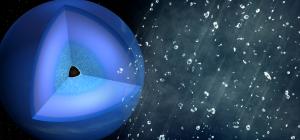
A cutaway shows the interior of Neptune (left). Image by Greg Stewart/SLAC National Accelerator Laboratory
It’s raining diamonds
It’s raining diamonds in the Laboratory. In an experiment designed to mimic the conditions deep inside the icy giant planets of our solar system, Lawrence Livermore scientists and collaborators observed "diamond rain" for the first time as it formed in high-pressure conditions.
Extremely high pressure squeezes hydrogen and carbon found in the interior of these planets to form solid diamonds that sink slowly down further into the interior.
The glittering precipitation has long been hypothesized to arise more than 5,000 miles below the surface of Uranus and Neptune, created from commonly found mixtures of just hydrogen and carbon. The interiors of these planets are similar -- both contain solid cores surrounded by a dense slush of different ices. With the icy planets in our solar system, "ice" refers to hydrogen molecules connected to lighter elements, such as carbon, oxygen and/or nitrogen.
Researchers simulated the environment found inside these planets by creating shock waves in plastic with an intense optical laser at the Matter in Extreme Conditions (MEC) instrument at SLAC's X-ray free-electron laser, the Linac Coherent Light Source.

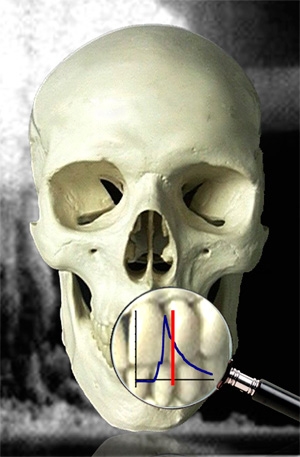
By using the bomb curve data from above-ground nuclear weapons testing during the Cold War (inset), Lab scientists can determine a victim’s birth year by examining dental enamel.
The window is closing
During the cold war, the U.S. and Soviet Union detonated 400 nuclear bombs above ground. Atolls were destroyed, steppes contaminated and fallout spread around the world. But what if some good came out of those nuclear detonations?
When all those bombs detonated, they spit out neutrons that set off a chain of events to create carbon-14, an exceedingly rare isotope of carbon. The amount of carbon-14 in the atmosphere spiked. That carbon-14 reacted with oxygen to make carbon dioxide. Plants breathed it in, animals ate the plants and humans ate the animals and plants. “Everyone alive has been labeled with it,” says Bruce Buchholz, a scientist at Lawrence Livermore National Laboratory. “The entire planet has been labeled.”
And that labeling has allowed scientists to pinpoint a sample’s age within just a year or two. They can use the method to find the age of an unidentified body using tooth enamel, or study how often human fat cells are born and die, or discover how old trafficked ivory is. It works with literally anything that has carbon.
Carbon-14 is not dangerous to humans-but it is very useful, because levels of the isotope have been slowly falling off since the 1950s spike. But as the years go by, the amount of carbon 14 in the atmosphere is diminishing, closing the window to precise carbon dating.

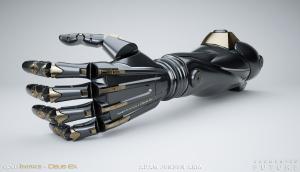
Research by Lawrence Livermore scientists shows that exposure to antibacterial chemicals common in personal care products such as soap and lotions can transfer from mother to offspring and cause adverse effects.
Beware that antibacterial soap
During pregnancy, it's wise to avoid sushi and cold cuts, specific medications -- and now a certain ingredient in products such as hand soap and lotion.
It’s common for pregnancy to cause changes to the skin, and it’s important for moms-to-be to know what’s in their skin care products -- because they might have an affect on the unborn child.
New research by Lawrence Livermore scientists warns against triclocarban (TCC), an antibacterial chemical often found in antibacterial soap, lotion and other personal care products.
Exposure to environmental levels of TCC can transfer from mother to child and interfere with lipid metabolism, which means that fats (lipids), such as waxes, fat-soluble vitamins, monoglycerides, diglycerides and triglycerides, won’t get digested by the body. While avoiding fat metabolism might sound like a good thing, fats store energy and are crucial to nerves and cells structure.

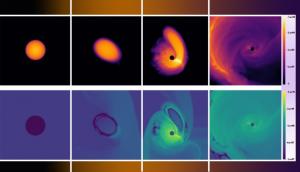
Despite staggering differences in mass and scale -- the sun (left) is approximately 10^38 times more massive and 10^13 times larger -- NIF implosions (right) are being used to recreate the conditions found in the deep interiors of stars so that they may be better understood.
Lab scientists see stars
Lawrence Livermore scientists have used powerful lasers to create the high temperatures and pressures found inside stars 40 times more massive than our sun.
For the first time, the team recreated the extreme stellar plasma conditions of nuclear reactions found inside the hearts of stars.
Almost all of the heavier elements in the universe, including oxygen, are formed in nuclear reactions inside stars. These reactions take place under incredibly high temperatures and pressures, making it nearly impossible for scientists to perform nuclear measurements in similar conditions -- until now.
The new experiments are the first thermonuclear measurements of nuclear reaction cross-sections, which help scientists measure the probability that a nuclear reaction will occur.

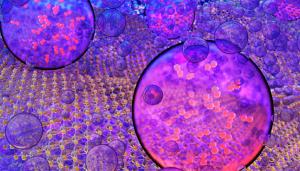
Hydrogen gas bubbles evolve from water at tantalum disulfide electrocatalyst surfaces. Catalytic activity in layered metal dichalcogenides like these is usually limited to edges, but this work reports new materials that also can generate hydrogen at the surfaces. Image by Ryan Chen/LLNL
A new type of fuel bubbles up
LLNL scientists and collaborators have developed a technique that helps extract hydrogen from water efficiently and cheaply.
Hydrogen can be used as a clean fuel in fuel cells, which produce power, with water and heat as the only byproducts. As a zero-emission fuel, the hydrogen can be recombined with oxygen to produce electric power on demand, such as onboard a fuel-cell vehicle.
The team turned to electricity to produce clean hydrogen fuel by splitting water molecules, which are made of oxygen and hydrogen atoms. The researchers discovered a new class of cheap and efficient catalysts to facilitate the water splitting process.





